Old Fashioned Dress Front Lace Up
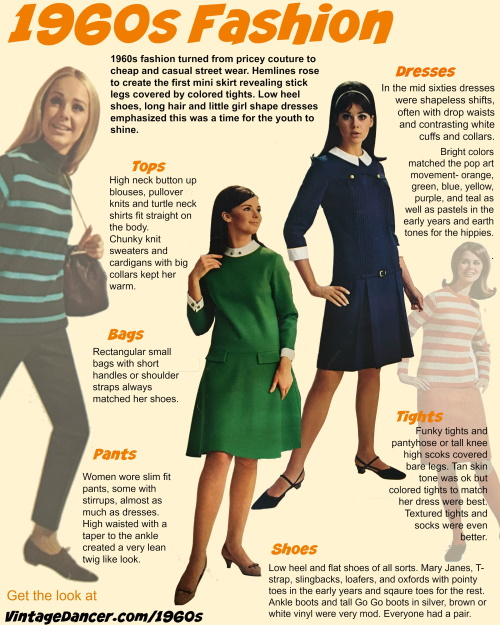
1960s Style for Women
Women's 1960s way was an farthermost style and attitude from the get-go of the decade to the end. In the early years, the mode idol was Jackie Kennedy with her perfect white pearls and tailored suit dresses. Past the eye of the decade, supermodel Twiggy had women freeing their minds and bodies into clothing that didn't require any extra idea or try.
From modest to "at that place is no such thing as too curt," 1960s fashion was in many ways like the 1920s flapper revolution. Simply it didn't happen overnight.
Skip the history and shop 1960s style clothing:
Dresses | Pants | Shoes | Tops | Coats
Women's 1960s Fashion Trends
- Jackie Kennedy, Brigitte Bardot, and Mary Quant were way icons.
- The Youthquake movement created "Babydoll" clothing.
- Curt, shapeless shift dresses in vivid colors and colorblock patterns became a staple of the Mod await.
- Button-downwards shirts, turtlenecks, and chunky knit sweaters made up casual outfits.
- Mini skirts or pencil skirts in plaid were a teen's school outfit.
- Jax pants, stirrup pants, bell bottoms, and pantsuits were new trends.
- Low heel flats, boots, and vinyl shoes made upwardly footwear.
- Stockings or tall socks came in all colors.
- Pop Fine art Jewelry emerged.
- Hair could be brusk and bobbed or long and directly.
- Hippie fashion – Blue jeans, ethnic clothing, psychedelic swirls, tie-dye in the mid-late 1960s.
1960s Fashion Icons
Jackie Kennedy's style was clean, simple, and well fitted, with perfectly matched accessories. She wore dresses without collars and jackets that buttoned but with i large top button. On her feet she wore sensible depression heeled shoes (although many women however preferred high heels). She was the concluding celebrity woman to wearable hats, a pillbox hat, equally a necessary way. Jackie O' put a lot of intendance into her look, and women both in the USA and abroad copied her way with enthusiasm.
Sadly, afterwards her husband's assassination, Jackie was no longer in the public heart. Women had to find a new 1960s way idol to exist inspired by.
Brigitte Bardot was that woman. She was Jackie's opposite. Jackie was put together, simple and pocket-size. Brigitte was tacky, cheap, bold, and fifty-fifty silly. Her 1959 pink gingham wedding apparel with white lace trim was so unexpected that gingham and lace quickly became a new trend.
Mary Quant was another 1960s fashion influence. Her style moved abroad from "grown-up mode" to playful "youth" driven clothing. Her shift dresses were brusque, very short, and her prints were bold and colorful "mod" prints. Her way as well as her personality set the tone for the rest of the 1960s: "fashion is fun."
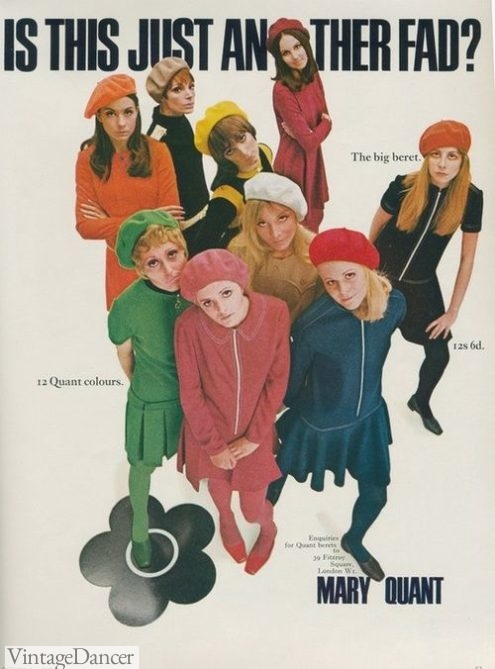
1967 Mary Quant Ad Featuring Beret Hats, Drib Waist Dresses, and Assuming Colors
It was the whole idea of a return to childhood that drove most of the fashion in the 1960s. Oversized collars, bows, and delicate trim miniaturized women and made them appear smaller. Shapeless mini dresses de-emphasized a woman's natural form. The flat and boxy look took away women's curves and made them piddling girls over again.
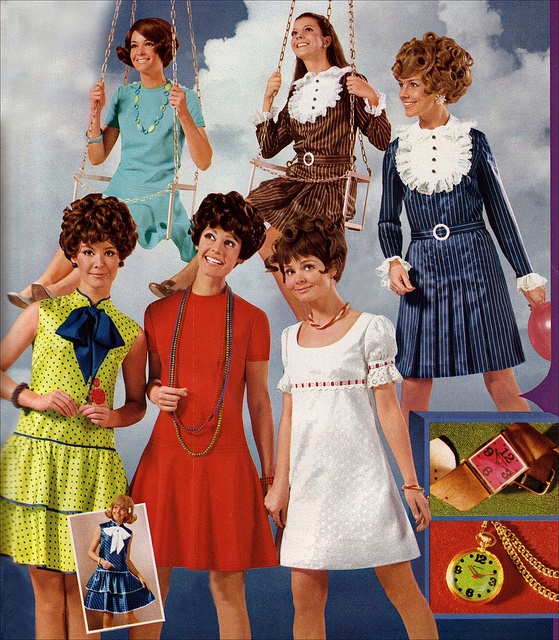
1960s Youthquake Outfits
Kitten heel pumps, Mary Jane strap shoes, and flat sneakers were all babyhood shoes returned to the '60s youthquake civilization. It was no coincidence that a young culture had a lot to do with one-half the American population being under 25 and with European countries having a similarly large youth population, as well. Later growing upward in the '50s as "little adults," the youth embraced their addicted early babyhood memories and fashions. By children's way, we hateful babies and toddlers. The "babydoll" look was incorporated into dress, hair, and even makeup.
1960s Dresses
The total skirt and tight bodice of the '50s swing dress continued in the early on '60s, with a slightly above- or at-the-knee hemline and modest high necklines. Colors and patterns were bigger, brighter, and streamlined with simple necklines and brusk cap sleeves. This total-skirted look didn't leave way in the 1960s. Instead, it carried through to the 1970s in a pared downward, less fluffy grade.
The other style of early on 60s dresses was the contoured sheath dress. Similar the 50s version, it was knee joint-length, modest, and simple, but tailored to the hourglass curve of the body. Past 1963, the sheath was losing its tight curves (a welcome relief) and relaxing into the shift dress.
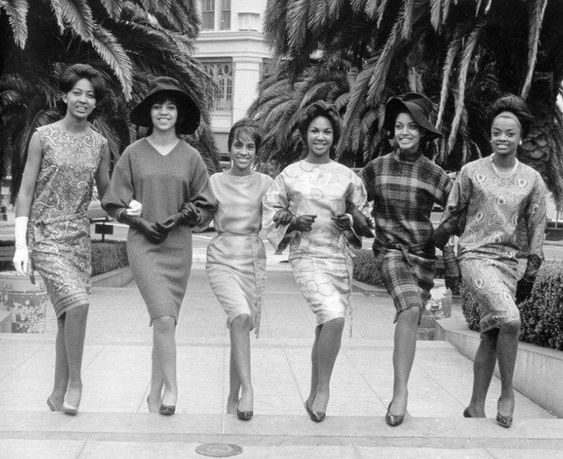
A Variety of Sheath Dresses Worn with Coordinated Gloves and Heels
The shift dress lacked any sort of tailored waistline, but did compression in slightly effectually the ribs and skimmed over the hips to just in a higher place the human knee. This loose merely narrow looking wearing apparel was very comfortable and easy to wearable. It became the primary women's dress style of the 1960s.
Skimmer dresses were a cousin of the shift wearing apparel. They fit straight on the trunk with a high neckline and (usually) a belt to define the waist, but not shape it. They "skimmed" the body without touching the pare. They besides hovered above the knee.
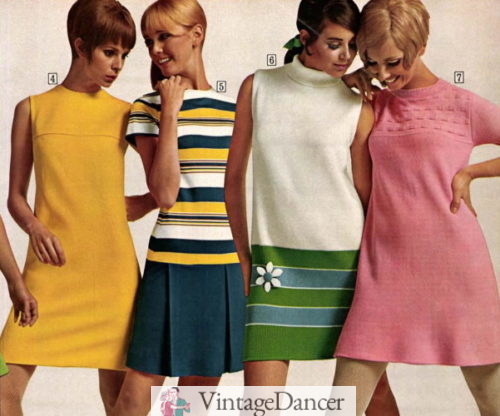
1968 Knit Shift Dresses for Women
The driblet waist clothes was a 1920s throwback where the skirt circled the depression hip and dropped to the human knee. Information technology was a chip more fitted than the shift dress, with a gathered or pleated brim. It seems to take been favored by mature women who were more used to a tailored fit.
1960s dresses became shorter and shorter. Anything higher up the knee was a "mini skirt." How short a woman's dress became a sign of how confident she was — not necessarily that she had groovy legs. Hem length was directly proportional to how women felt about their own sexual liberation. Curt skirts were not meant to attract men for the sake of sexual interest, but instead were a manner to concenter attention so that a Adult female could be the 1 to decide if his attention was wanted. It was sexual ability through style.
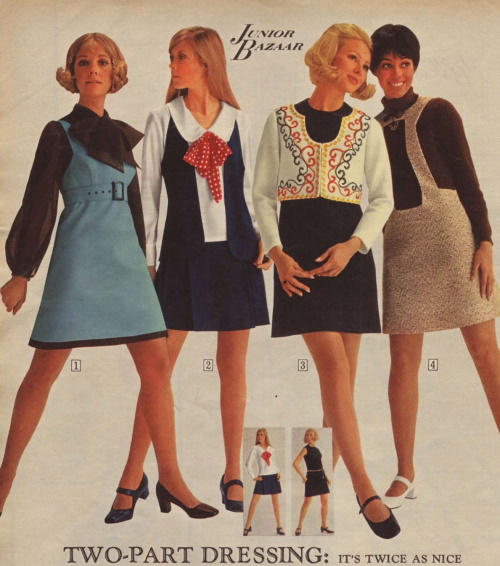
1969 Brusque Jumper Style Dresses with Big Bow Blouses and Neckties
The jumper dress was a Mary Quant invention that captured the youthful, playful side of 1960s fashion. That style immediately fabricated a 20-twelvemonth-old expect x, a welcome alter from the '50s mature fashion. Big bows, large round collars, pastels, and polka dots were all dress details that made women look like a lilliputian daughter's dolls. The more innocent, the better.
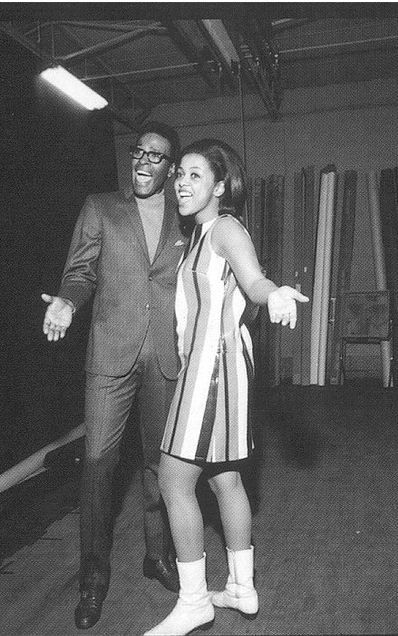
Marvin Gaye and Ammi Terrell, in the Late 60s, Wearing a Striped Dress and Go Go Boots – Very Mod!
Colors and prints were at first inspired by the pop art and modern art movements, AKA "Modernistic" civilisation. Checkerboard, horizontal stripes, windowpane, polka dots, colorblock, honeycomb, houndstooth and Campbell's soup cans were all placed on brusque shift dresses with contrasting white cuffs and collars. Blackness and white was especially Mod.
Psychedelic swirls and prints introduced a trippy border to clothing that was picked upwardly by the hippies around 1966-1968. Being over the top was never also much. Large paisley swirls, neon flower daisies, and tropical beach prints all made an advent. Bright yellow, orange, hot pinkish, and lime greenish were the favorites. These bold colors and loud patterns were seen on dresses, skirts, tops, and pants.
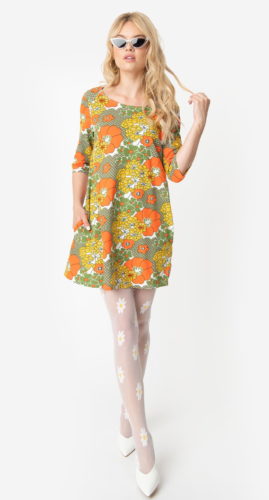
60s-70s Bloom Power Apparel with Daisey Tights. Store here.
There was too a tendency of earth tone colors, especially as the decade moved toward the hippie movement. Moss green, bawdy browns, mustard yellow, and burnt orange were common colors year-round. Come across more examples of vintage 1960s dresses here.
Store 1960s manner dresses.
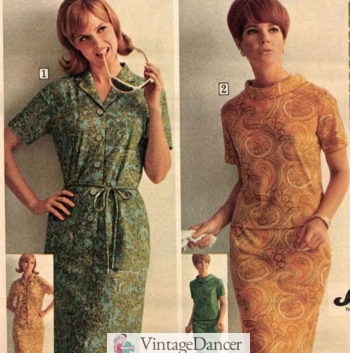
1968 Earth Tone Paisley Dresses
1960s Cocktail, Prom, and Evening Dresses
For swanky cocktail parties, the political party look of the '60s was the same short shift, tent, and skimmer dress styles in luxury fabrics, mostly in blackness … or white. The two-piece jacket clothes was a classic with mature ladies. For the young, dressy shell tops and cigarette pants were a welcome alter from dresses. In the late '60s, broad-leg jumpsuits became a type of hostess wearing apparel, acceptable for evening house parties.
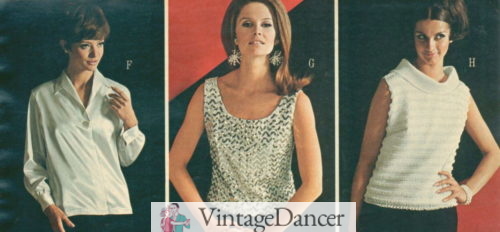
Evening Tops – Silk Blouse, Sequin Shell, Pleated Mock Neck
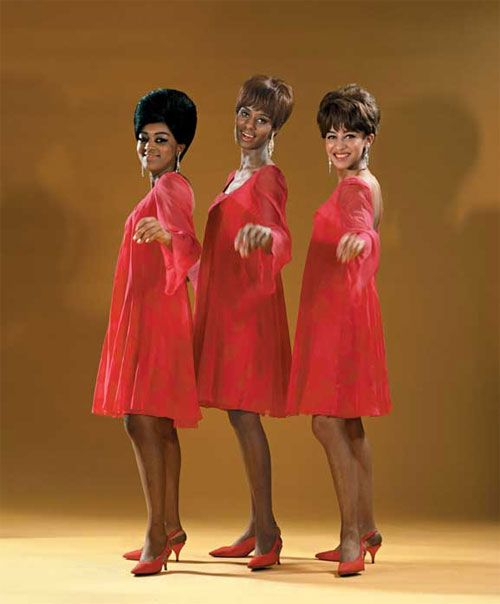
The Velvelettes Article of clothing Scarlet Chiffon Dresses, Late 1960s
Pastels were worn in the summer and rich precious stone tones in fall. Lace was a popular textile as well as velvet or a classic low-cal crepe. Most were undecorated, but some had braid and metallic mesh trim around the necks and hems. "Minimal" was the look to achieve.
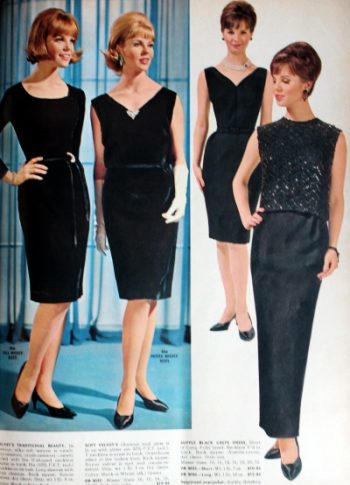
1964 Black Formal Party Dresses
For evenings and prom, the choice was between curt or long empire waist dresses. Ordinarily sleeveless, the longer dresses were shaped like a column with pleats at the back. The top was often a contrasting lace or damask material cinched in with a bow on the front or dorsum. Brusque evening dresses looked the same, but shorter. Many were tent shaped or A-line instead of the slim cavalcade shape.
Learn more about 1960s cocktail party/evening habiliment/nuptials party attire here.
Store 1960s party and evening dresses.
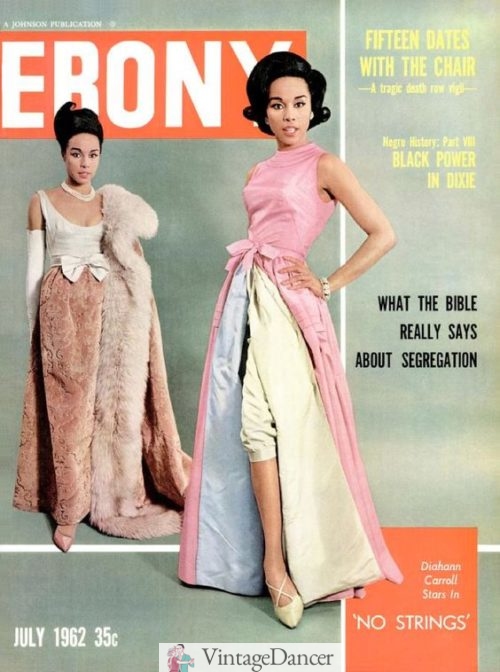
1962 Evening Dress and Hostess Gown (Pants Underneath Brim)
1960s Tops, Sweaters, Coats
Tops, shirts, blouses, and sweaters all took direction from coincidental article of clothing in the 1950s. The primary modify was that shirts and sweaters now fit straight on the body, with no emphasis on the bosom or waist.
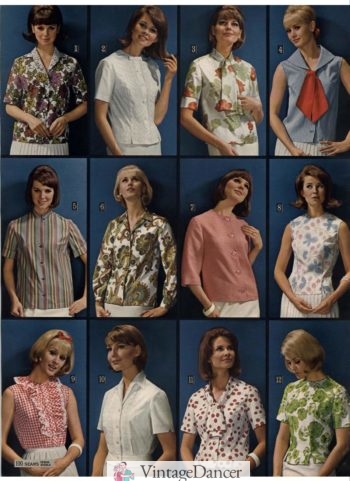
1965 Indigestible and Minor Button-Up or Sideslip-Over Tops boxy and modest button up or slip over tops
Tops could also be worn untucked. Gasp! They hung out over pants and skirts and grew longer as the decade advanced. Necklines also grew higher, back to the modest look of the 1930s.
The mock cervix blouse or knit shirt was a classic. Sleeveless in summer and typically called shells, the fit was ever indigestible. They were casual solid tops worn with pants and shorts. Long sleeve black turtlenecks were a uniform of the Beatniks in London, but in the U.s. horizontal stripes were worn past every young person.
Large coil collars, round Peter Pan collars (frequently in contrasting white), big bows, and pointed shirt collars called attention to a thin cervix and short hair. Button up shirts took on the wait of menswear with round or straight hems, oversized collars, and bold prints. Bright colors and big prints made colorful statements when paired with a solid color matching pant. Learn more than nearly 1960s blouses, tops, and shirts.
Shop 1960s tops and shirts here.
Knitted sweaters were usually solid colored pullovers or in the boxy cardigan style. '60s knitwear designs favored texture — thick textured cable knits and wide rib knits were very popular. Many had big fold-out collars and oversized ringlet necks. Cardigans were ordinarily collarless with some unique print in the early to mid-'60s such every bit minor argyle, checks, chevron, or florals.
Read more virtually 1960s knitwear and sweaters and shop 1960s sweaters and cardigans.
For winter vesture, a good wool coat was withal necessary. 1960s women's coats narrowed down and shortened upwardly to fit over new, thinner, clothes. Round collars with large buttons, flap pockets, geometric prints, and maybe a chugalug kept them looking cute and fun. They came down to just above the knee so that long, lean legs would continue to be the focal point.

The Temptations and The Supremes with Fabled 1960s Coats
Short jackets, especially those made of suede and leather, were popular options for the young and casual. Shiny plastic-like vinyl was even more than trendy with the infinite-age loving modern set. Most women, still, chose a blazer-type jacket that was dressy enough to exist worn with dresses, but as well casual plenty to be worn with pants on the weekends.
Shop 1960s coats and jackets.
1960s Skirts
1960s skirts came in knee lengths with classic circle skirts/swing skirts, straight pencil skirts, and box-pleated A-line skirts (school daughter fashion) in the early to mid 60s. Plaid patterns were very popular in the autumn and winter, and solid pastels in spring and summer.
The late '60s saw the starting time shocker – the mini brim – enter fashion. Mini skirts were 4-6 inches above the human knee in box pleats or A-line button front shapes. Plaids, pleats, corduroy, and heavy knits were perfect for minis. They were worn with tights and tall go go boots by teens and trendy college-age girls.
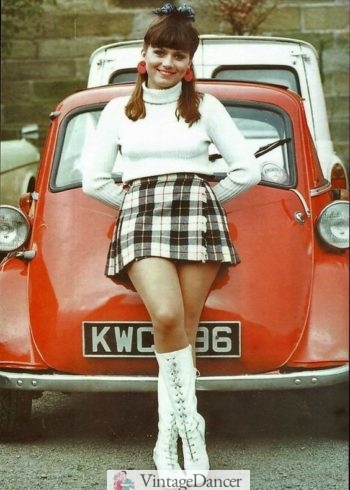
Turtleneck Pinnacle, Plaid Mini-skirt, and Lace-Upwards Go Get Boots
Mature women didn't wear minis. They went the reverse management – longer! Button forepart knee joint-length skirts, knee-length skorts, and at-the-human knee denim skirts were all newer options for women.
The maxi brim came about at the end of the decade also. Women and girls of all ages loved them. They were gathered at the waist, sometimes with a tie bow, and hung down in a column shape. They took inspiration from prairie dresses and were made in hippie loving calico prints or swirly psychedelic eye poppers. In the evenings, they were quilted or made with shiny taffeta fabrics.
The 1960s style skirt has returned to fashion this year. Shop mini skirts, A-line skirts, long maxi skirts, denim skirts, and more.
1960s Pants
Jax pants with a very high waist, shaped hip, and slender leg continued to exist favorites from the 1950s. They were commonly lined, with side zippers and no waistband. They could be worn with blouses tucked in, just more oftentimes had longer tops untucked. Crop tops were a favorite in summer — never too short, but occasionally long enough to overlap the pants' waistband.
The stretch pant and stirrup pant took advantage of a new kind of knit fabric. Easy to sew together and wear, the elastic stirrup under the foot kept pants smooth and direct. It didn't matter that the stirrup was visible. When ankle boots came into style, suddenly visible stirrups were taboo. Boots must be worn!
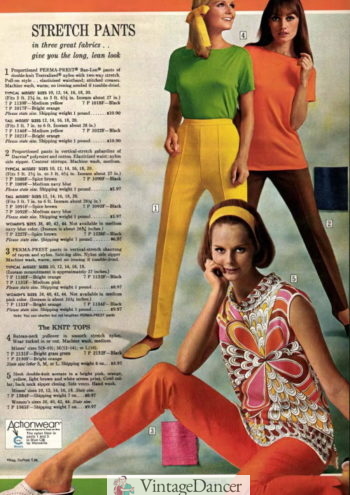
1968 Stretch Pants
All pants / trousers came down to just to a higher place the ankle until the late '60s, when longer pants became the new trend. They too withal zipped upward the dorsum or side for most of the decade, but moved to the front for trousers and jean styles.
Pants were loftier waisted (circling the omphalus) except for the youthful hip hugger styles that appeared in the mid '60s. They were more pop in Europe than America, and very trendy with the Mods and Beatniks.
Denim jeans followed the fit and mode of slim pants: high waist, tapered leg, ankle crop, and in many more colors than just blue. White was especially trendy. Blue jeans were not as common as y'all might expect. They somewhat disappeared in the 1960s, only to return with a vengeance in 1969 with a flared kick cut.
Flare jeans and pants may have started in the 1960s, but didn't go mainstream until 1969 and into the 1970s. There were a few casual flared leg pants designed as early on as 1967, but for the most part, flared jeans and bong-bottom pants were not function of the 1960s. Even the hippies wore straight-leg pants in the 1960s. Acquire more virtually 1960s pants, capris, jeans and culottes.
Shop 1960s manner pants here.
1960s Suits
Women's suits, like the '50s, were dresses (or skirt and top separates) worn with a matching short jacket. They were the almost professional person selection for looking polished and lady-similar. Mature women liked the tailored suits with pencil skirts and cropped jackets, while young women embraced the knit suit with an open cardigan style jacket or calorie-free blazer.
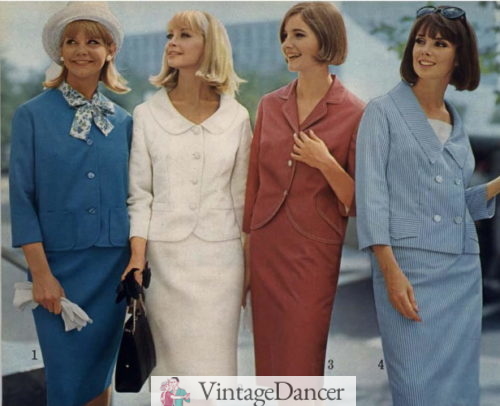
1965 Suits
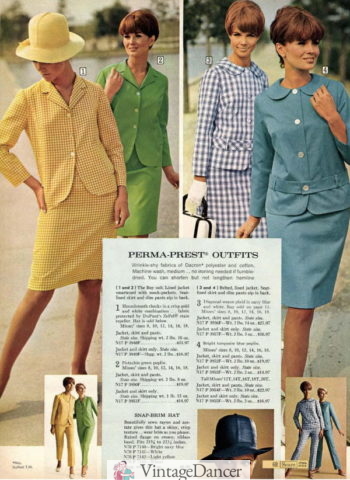
1968 Dress Suits and Pantsuits
As shocking as a mini skirt was to society, in that location was an equal confusion over the new pantsuit. It was a wait direct copied from men's suits, but tailored down to feminine proportions. Some piece of work offices and establishments forbade women from wearing pantsuits. There was confusion over whether they were an insult to femininity or empowerment for women (which "disrespected men"). While 1960s mode magazines debated, women flocked to the stores to buy them. They were already wearing casual pants everywhere else, so wearing dressy pants seemed merely natural.
1960s Shoes and Stockings
With legs now fully exposed by brusk hemlines and the youthful girl expect on-trend, shoes took a drastic turn from high fashion with loftier heels to street fashion with depression to no heels. Flats were in. Inexpensive was in. Color was in. Sophistication was out.
Thanks to new materials, notably PVC (Vinyl), shoes could be mass-produced for cheap and come up in a lot of bright colors to match dresses. The depression heel made them like shooting fish in a barrel to walk and live life in. All the designs of the earlier decades– loafers, Mary Janes, T-straps, monk straps, ballet, saddle shoes, and Oxfords — were designed into a low heeled shoe for the '60s.
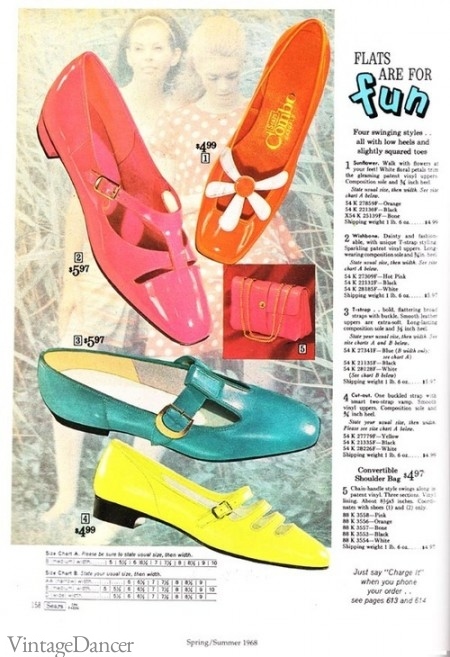
1968 Colorful PVC Shoes
Tall and skinny stiletto heels were nevertheless an pick for evenings. The single strap Mary Jane came back in fashion, as did the slingback with cutouts on the sides.
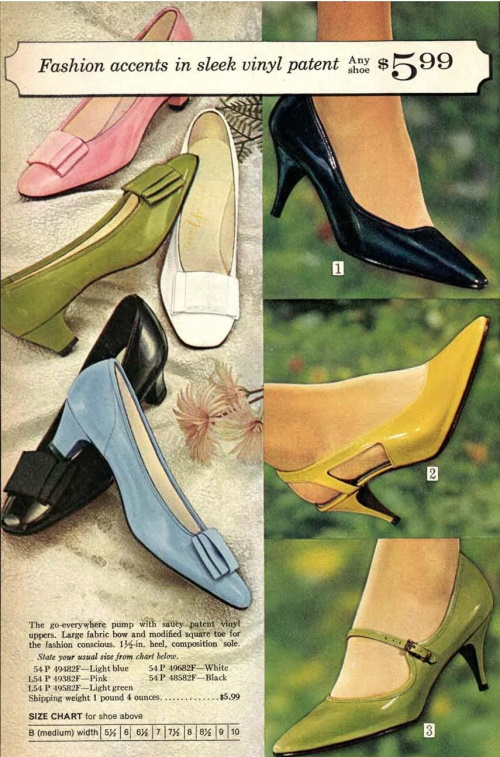
1968 Heeled Shoes
Even boots had flat heels. Thanks to an interest in all things futuristic looking, alpine boots in white or silver became the new black. Everyone wore them. They looked bang-up with short dresses and skirts. The tall white boots were called go-become boots, named after nighttime guild dancers in LA who wore them. Teens loved them and wore them with mini skirts to schoolhouse (if they were allowed).
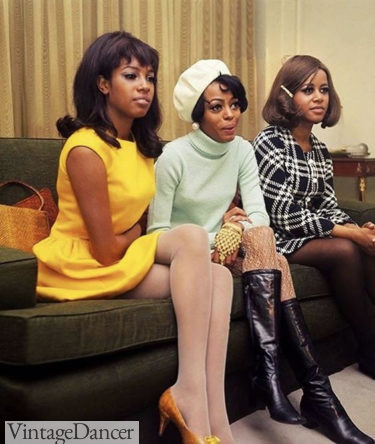
The Supremes Wear Heels and Tall Boots
In the late '60s, suede boots in natural colors dominated autumn and wintertime fashions. Both tall and brusque styles were worn with short shift dresses. Booties could be worn with long pants too.
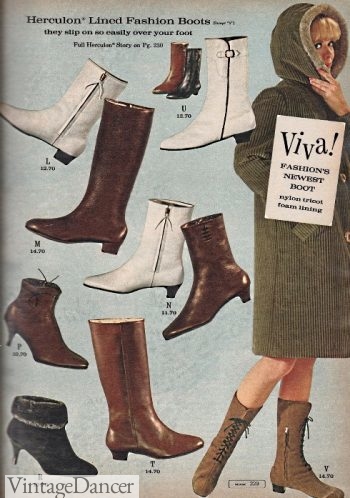
1960s Boots
In the summer, information technology was the sandal heel, flip bomb, and mule that had women feeling absurd in the heat. Colors were bright and the straps were either very wide or very skinny. Sandal heels had a closed square toe, whereas casual sandals had a big open toe. Sandals were every adult female'southward new favorite shoe. They could be worn with almost whatsoever outfit at any time of mean solar day, and not expect out of place.
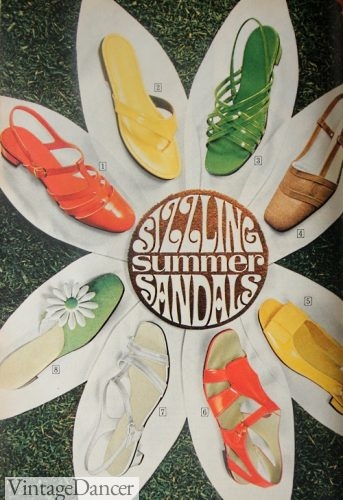
1968 Sandals
Casual shoes were canvas apartment sneakers that nosotros often refer equally the brand name "Keds" today. They were either skid-on loafers or lace-upwards sneakers in bright, happy colors, chosen to coordinate with an outfit. They were inexpensive, so women could afford to have one in every color. In the spring and summer, they were worn without socks.
Read more than about ALL the 1960s shoe styles here.
Store 1960s Style Shoes.
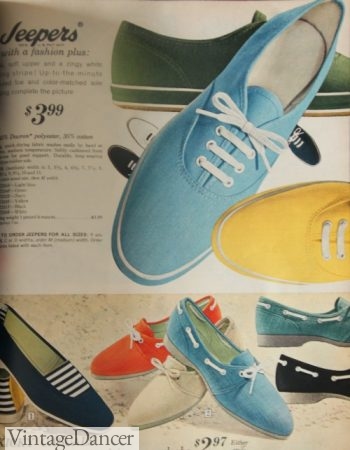
1968 Jeepers Sneakers
Colored tights were worn with short skirts and dresses in a variety of colors and textures: white, black, purple, yellow, light-green, orangish, fishnet, herringbone, ribbed, and lace. Tights covered up ugly knees and didn't cause garter gaps similar sheer stockings did.
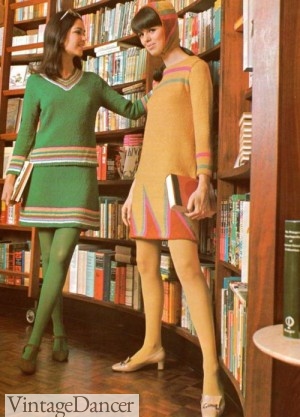
1968 Colored Tights
Once pantyhose were perfected, they were the savior of women'south legs anywhere. They camouflaged pilus, bumps, bruises, and wide kneecaps. Even skin tone tights were thick and dark. To become bare-legged with dresses in the '60s was nonetheless as well immodest. Ironic? Shop colorful tights and socks inspired by the 1960s.
Alpine socks could be worn instead of tights. Chunky rib knits with a fold-downward cuff were a mainstay for teens and young adults. All primary colors were worn.
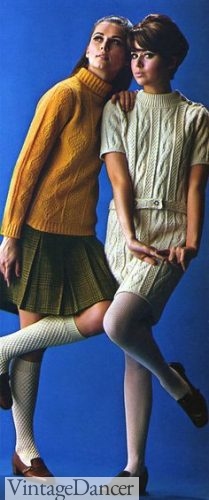
1960s, Articulatio genus High Socks and Tights were Equally Popular
1960s Jewelry
Colorful 1960s clothing needed equally colorful jewelry. In the early on years, traditional jewelry connected to favor textured gold, white pastel, and colored pearls. These pretty and safety designs complemented the feminine 1950s style article of clothing. The one modify was the length. Longer pearls and tassel tip necklaces were preferred over the older short styles. They hung down depression on plain front shift dresses merely were usually of a matching color so equally not to distract from the apparel. Round button earrings or small chandelier earrings matched necklaces.
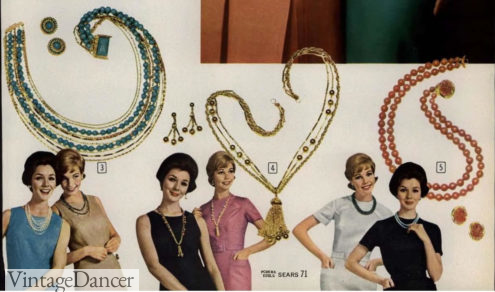
1962 Long Pearl and Tassel Necklaces
The new youth with their obsession with faux plastics, vinyl, and bold colors favored jewelry inspired by Pop Art. Geometric shapes made their mode onto over-sized dangling earrings. Big chunky bangles or stacks of thin bracelets jingled up and downwards bare arms. Novelty shapes were nevertheless popular, but they embraced brighter colors and more comical themes.
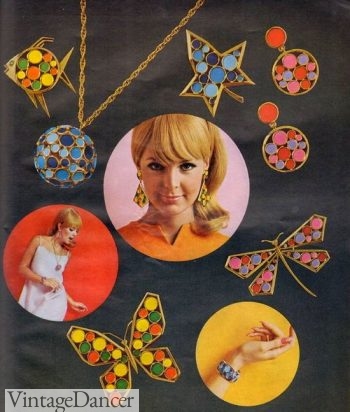
1967 Trifari Colorful Jewelry
The same went for flowers, now fabricated from plastic resins. They were cheerful pastel or master-colored clusters hanging from necklaces, earrings, and bracelets.
Acquire more about 1960s jewelry styles here.
Shop 1960s inspired jewelry.
1960s Hairstyles
Without a chapeau to call attention to a adult female's caput, hairstyles became a new focus for women. The bouffant await teased hair to new heights… literally. Guiche curls kissed her cheeks (made possible past a bit of nail shine to keep them pointed to a crisp). All that book fabricated faces appear smaller and more doll-like. Hair length rose from shoulder to chin to cropped above the ears every bit the decade progressed, only to come crashing down again in the '70s.
Headbands were a trendy pilus accompaniment. Simple, wide satin headbands swept hair away from the confront. Hair scarves/bandannas were also trendy in the later half of the decade. Cloche hats experienced a revival with the mod await. Pillbox hats and flower pot hats were in mode with the early 60s looks. See more examples of 1960s hairstyles here.
Shop hats, pilus accessories, and wigs here.
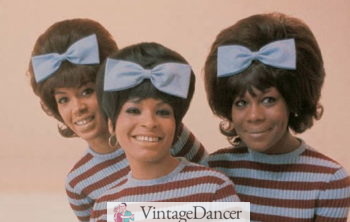
Early 60s Bouffant Hairstyles with Bows Worn past The Marvelettes

Mid '60s Hairstyles

Short Mid '60s Hairstyles- Curls or Bob
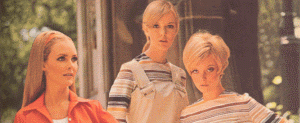
1968 Long Hairstyles- Long and Curt

1969 Long Hairstyles and a Short Bob
1960s Makeup
The early on 60s saw the exaggerated cat eye and total scarlet lip go along. Eyebrows were shaped into subtle peak instead of a high curve. Pink blush was subtle and nigh not-existent. There were also makeup styles for the modern await (AKA babydoll face), specialty products for black women, looks for eveningwear, and others. Learn more about 1960s makeup and buy vintage makeup colors.
- Powder – Flesh tone.
- Chroma – Soft rose pink.
- Center Shadow – White-pink, purple, light blue, aqua.
- Eye Liner – Dark brown or black, tiptop and bottom lined and extended outwards.
- Lipstick – Deep pink, orange-red.
- Eyebrows – Shaped into a soft peak.
Late 1960s Fashion: The Hippie Await
The late '60s saw a movement of anti-fashion, a political statement that grew and then popular it became a mainstream mode style. Existent hippie wearable and hippie manner were completely unlike. Early on, festival going hippies wore mainstream fashions such as the shift dress in psychedelic colors of 1966-68. Tye-die was popular in 1968, taking obviously white men's undershirts and dyeing them with multiple colors. The more color, the better — and the gaudier the colors, the meliorate!
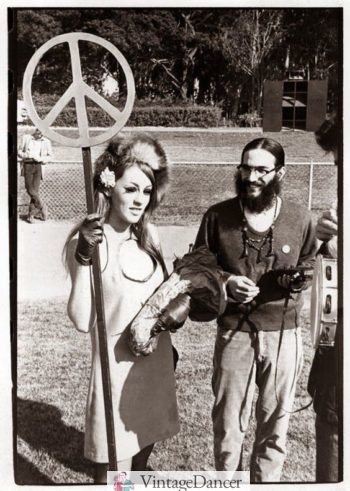
1967 Festival Outfit – Mod Shift Clothes with Handmade Headband and Fingerless Gloves
In 1968-69, the fashion shifted to globe tones, faded denim jeans, embroidered tops and tunics, and handmade accessories such as headbands, friendship bracelets, and hair wraps. The flower kid ornamentation of patches, embroidery, painting, and peace signs were added by many hippies to brand their jeans feel less commercial or to make an anti-war statement.
Hippie fashion influenced mainstream designers who turned dorsum to the downwardly to globe, homemade, ethnic arts and crafts styles. Wood green with brown suede, and sunshine yellow with denim blueish were signature colors of the ethnic-hippie '60s. Crochet pieces, suede vests, forest beads, headbands, sandals, and embroidered trim decorated shift dresses or flared jeans. It was a blend of current silhouettes and folk art decoration.
Learn more well-nigh 60s hippie mode influences, history of 60s hippie clothes and bank check out these 10 hippie outfit ideas.
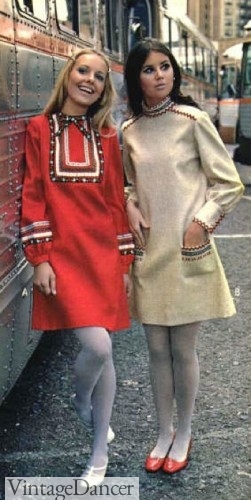
1967 Folk Designs for Emerging Hippies
The 1970s continued the hippie tendency into mainstream fashion. The youth-oriented looks turned to the complete reverse — granny style. Romanticized granny clothes from several generations ago, like pioneer women, returned mode dorsum to long dresses and sleeves, ruffles, lace trim, small cotton prints, and long pilus (worn downwardly this time, not upward). The age of the mini skirt "grew upwards" and turned into adults, not similar their parents but instead like those of generations before, which seemed to have a uncomplicated life that hippies idolized. Continue learning about 1970s mode here.
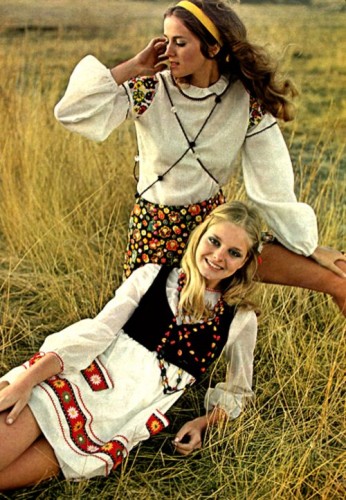
Late threescore's "Peasant" Style Hippie Dress
Read More than
- 1960s Hairstyles for Women and Teens
- x Hippie Outfit Ideas for Women
- 1960s Women'due south Outfit Inspiration
- 1960s Dress Styles | Mod, Casual, Classy
- More about 1960s fashion, read upward here.
1960s Fashion for Yous
Dresses | Shoes | Pants | Jackets | Costumes
Need more assist with your 60s outfit? Only ask united states someday!
0 Response to "Old Fashioned Dress Front Lace Up"
Post a Comment